No products in the cart.

On October 1, 1979, General Olusegun Obasanjo handed over power to President Shehu Shagari to usher in Nigeria’s Second Republic. It would be the second time Nigeria would be under democratic rule since the military coup of January 15, 1966, that led to the fall of the First Republic.
During the First Republic, Nigeria experimented with the British Westminster-style parliamentary system of governance where the positions of a powerful Prime Minister and a ceremonial President were created. Sir Abubakar Tafawa Balewa and Dr Nnamdi Azikiwe would hold these positions until the military struck and brought an end to democracy in Nigeria.
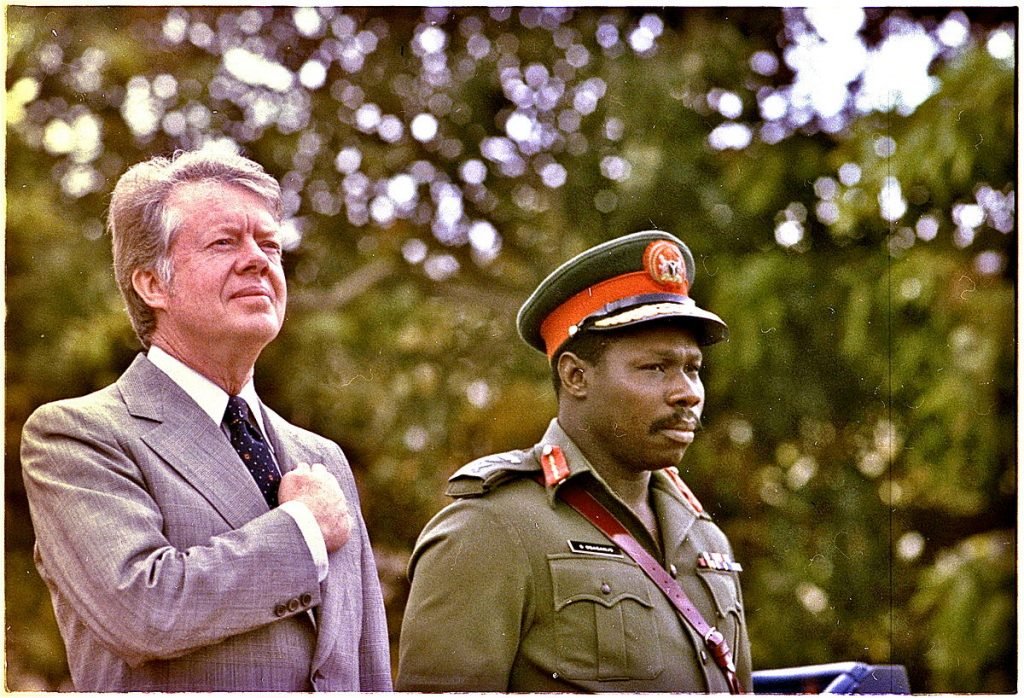
When, in 1979, the opportunity for democracy rose again in Nigeria, the Head of State, General Olusegun Obasanjo, however, ditched the British-style parliamentary system and opted for the American-style presidential system which ushered in Nigeria’s first executive president in Shehu Usman Aliyu Shagari.
Contents
How Obasanjo did Americanize Nigeria is the subject of this article.
Olusegun Obasanjo: A Background
Olusegun Obasanjo was born around March 5, 1937, in Ibogun-Olaogun, a village in present-day Ogun State. His exact date of birth remains unknown. He attended Saint David Ebenezer School in his village before moving on to Baptist Boys’ High School in Abeokuta.
Obasanjo joined the Nigerian Army in 1958, specializing in engineering. He was later assigned to Congo, Britain, and India. Interestingly, Obasanjo would return to Nigeria from a course in India on the exact day Nigeria’s first military coup was carried out by his friend and roommate – Kaduna Nzeogwu.
Olusegun Obasanjo played a major role in ending the Nigerian Civil War with the Biafran soldiers surrendering to him in January 1970. This outcome made the then Colonel a war hero.

The bloodless military coup of 1975 which saw the overthrow of General Yakubu Gowon, established a junta with Obasanjo as a part of its ruling triumvirate. The other two were Murtala Muhammed, as Head of State, and Theophilus Danjuma, as Head of the Nigerian Army. Olusegun Obasanjo was Chief of Staff, Supreme Headquarters – Second in Command to Murtala Muhammed who was militarily his junior.
After the assassination of General Murtala Muhammed on February 13, 1976, during an unsuccessful coup attempt, the Supreme Military Council appointed Obasanjo who then became Nigeria’s fourth military Head of State.
General Olusegun Obasanjo as Head of State (1976-1979)
When Obasanjo became Head of State, he inherited a foreign policy that was virile, dynamic, and proactive. He brought in Shehu Musa Yar’Adua as his second-in-command and Danjuma still held his position as Chief of Army Staff.
Following the footsteps of his former boss, he gave unflinching support to the liberation movements in different African countries that had yet to gain independence.
Foreign Policy
Some of Obasanjo’s foreign policies include supporting all liberation movements in Southern Africa, making Nigeria a distant frontline state, condemnation of apartheid rule in South Africa, nationalisation of British Petroleum to African Petroleum (AP), nationalisation of Barclay’s Bank to Union Bank, and assisting poor African countries in cash and resources.
Under Obasanjo’s regime, Nigeria witnessed a lot of proactive initiatives, winning the respect of the international community such that Nigeria became the “go-to” for the resolution of African conflicts.
This played out when Nigeria was part of the United Nations committee that saw the resolution of the Rhodesian (now Zimbabwe) conflict.
Obasanjo’s dynamism also paved the way for enduring friendships with world leaders like American President, Jimmy Carter and German Chancellor, Helmut Schmidt. This period marked the emergence of Nigeria as the “Giant of Africa”.
All these achievements were made possible mainly due to Obasanjo’s personal vision and dynamism, the oil boom, which was the financial muscle backing Nigeria’s “power diplomacy”, and the military hierarchical structure which made his actions unquestionable.
Although the Supreme Military Council was the highest ruling organ of the Armed Forces, the Head of State, who was the most senior military officer, had the final say. This privilege made it easy for Obasanjo to take decisions without having any objections from any quarters.
General Olusegun Obasanjo also displayed a radical approach to the implementation of foreign policies and was totally against colonialism. All these actions put Nigeria on a high pedestal as the country was able to take an independent position on issues bordering on African liberation.
Domestic Policy
In terms of domestic policies, Obasanjo introduced the Primary Education Act in 1976, which made enrolment free, to encourage universal primary education in Nigeria. He also introduced free secondary education in technical subjects but had issues with the tertiary level.
University funding was cut back, student loans were stopped, and there was a sharp increase in university food and accommodation charges. This led to student protests and the Obasanjo regime closed several universities. Political activities were banned and the National Union of Nigeria Students (NANS) was proscribed.
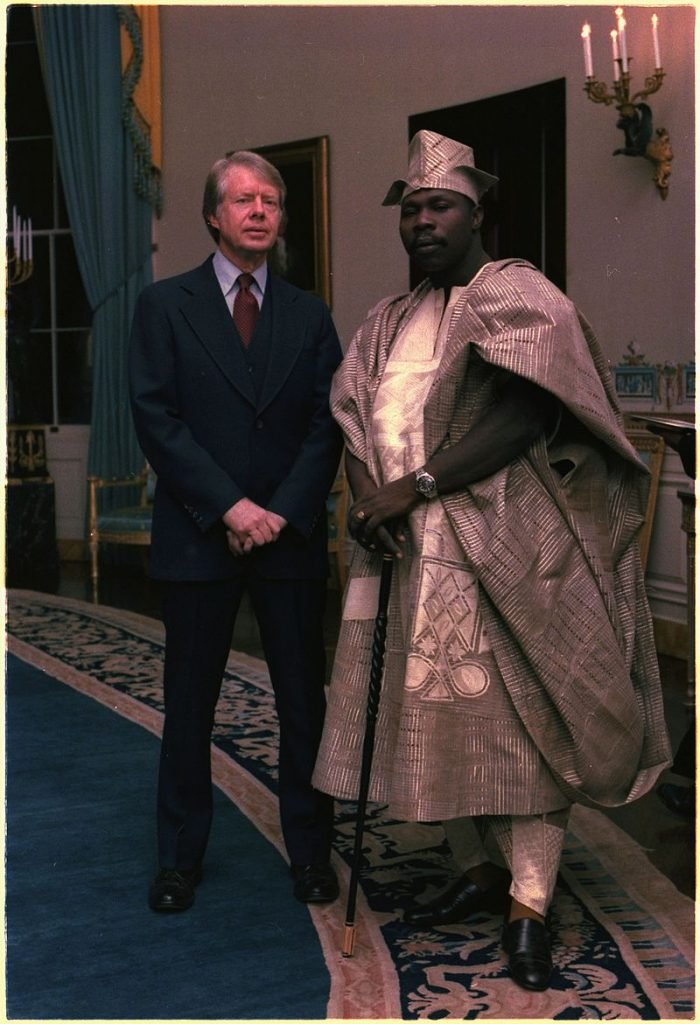
Nigeria saw rapid growth in the public sector but there were accusations of corruption against Obasanjo, although no evidence was presented to back them up. The Head of State was sometimes accused of focusing more on aligning with the Western world rather than focusing on the issues taking place at home.
Americanizing Nigeria
On his accession to the highest office of the land, Olusegun Obasanjo loosened Nigeria’s longstanding ties with the United Kingdom, aligning instead with the United States.
He was favourable to President Jimmy Carter, who won the 1976 U.S. elections, because of his commitment to ensuring majority rule across Southern Africa.
The then U.S. ambassador to the United Nations, Andrew Young also formed a close friendship with Obasanjo. In 1978, President Carter even visited Nigeria, making him the first U.S. President to do so.
In contrast, Obasanjo’s government was at loggerheads with the British for their refusal to extradite General Yakubu Gowon to face trial for his alleged involvement in Murtala Muhammed’s death and once considered suspending diplomatic relations with them but did not.
Obasanjo’s Grouse with Britain
As the Head of State, Obasanjo refused to visit the UK, an act that was the norm for previous leaders, and he discouraged his officials from doing the same. Instead, he visited the U.S. in October 1977 and addressed the United Nations General Assembly. Two weeks after his visit, Nigeria got a seat on the United Nations Security Council.
The nationalisation of British Petroleum and Barclays Bank were in retaliation to the British Prime Minister, Margaret Thatcher’s friendly approach to white minority administrations of Rhodesia and South Africa.
Nigeria distanced herself from British efforts to end the Rhodesian-Bush War and was left out of having a major role in the UK-brokered process that led to multi-racial democratic elections in Rhodesia.
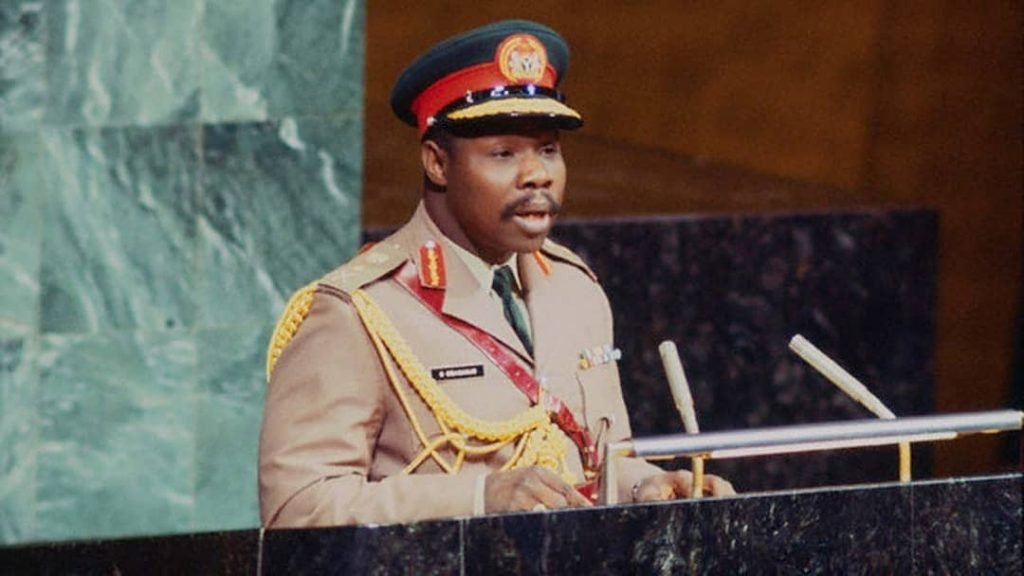
Just as the U.S. plays a major role in settling conflicts between countries, Obasanjo tried to do the same in Africa. He attended OAU (formerly known as the Organisation of African Unity, now African Union, AU) summits and proposed the formation of a standing committee to mediate disputes between the OAU and member states.
He also encouraged the formation of a Pan-African military that could engage in peace-keeping efforts on the continent.
Handing Over to a Civilian Government
Within the period since when Nigeria gained its independence in 1960, the Nigerian military has ruled the country for 29 years, plagued with a series of coups and counter-coups.
Some military governments promised to hand over power to civilians while some even began the process of transition but they never saw the light of day.
Major-General Johnson Aguiyi-Ironsi promised to hand over power but his government was overthrown; General Yakubu Gowon started the transition process but later postponed it indefinitely while General Murtala Muhammed, who restarted the transition process and would have handed over power, was assassinated.
All these showed a lack of sincerity on the part of the military to successfully hand over power to a civilian government.
General Olusegun Obasanjo was the third military ruler in Africa to hand over power to a civilian government. He followed his predecessor’s timetable for a return to civilian rule and made sure the 1979 elections produced a winner.
Nigeria’s Second Republic: From Parliamentary to Presidential
The Obasanjo regime then assembled a constituent drafting committee to devise a new constitution that could be used for the transition from military to civilian rule. The committee argued that Nigeria’s system of governance should be changed from the British parliamentary system to the U.S. presidential system.
However, in order for the president not to become a dictator, the committee suggested a federal structure where independent elected institutions would exist at the federal, state, and local levels.
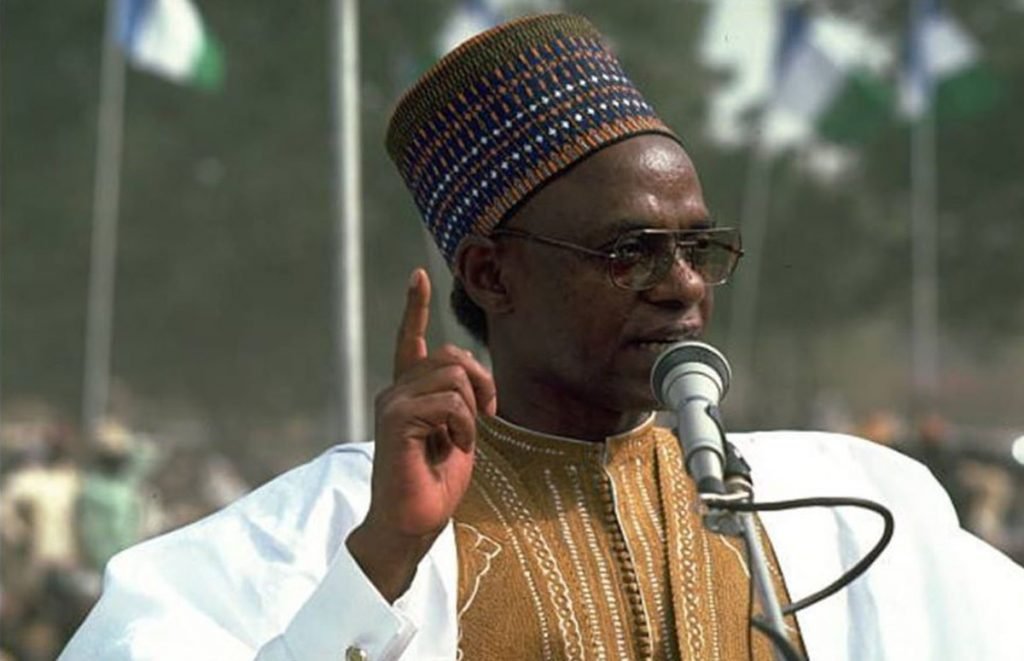
In October 1976, the draft constitution was published and debated in public for the following year and in September 1978, the Supreme Military Council announced the new constitution.
In line with the new constitution, Obasanjo lifted the ban on political parties and elections were held in July and August 1979.
Alhaji Shehu Shagari won the presidential election, with Alex Ekwueme as his Vice, and was sworn into office on October 1, 1979, which was the 19th year celebration of Nigeria’s independence from Britain.
At his inauguration, Obasanjo handed Shagari a copy of the new constitution. An American-style Senate, House of Representatives, and a federal system of governors for the country’s then 19 states ushered in the start of Nigeria’s Second Republic.
For the next two decades, Obasanjo was celebrated for his role in handing over power to a civilian peacefully despite the controversies that arose from the election.
Obasanjo then retired from military service to devote himself to farming but the victorious entry to democratic rule was short-lived as Shagari’s government was overthrown by General Muhammadu Buhari on December 31, 1983, just a few months after his reelection for a second term in office and the military were back in power.
Nigeria experienced more coups and different Heads of State before returning to civilian rule and ironically, Obasanjo, who had erstwhile been imprisoned by General Sani Abacha for allegedly planning a coup, was elected president in February 1999.
A new constitution was enacted on May 29, 1999, which saw the emergence of the Fourth Republic which remains in force to this day.
The Aftermath of Obasanjo’s Americanization
Growing ethnic tension in the country has implicated the presidential system of government as a contributory factor. Calls for restructuring and a review of the model have been resounding in the air for quite some time now.
The parliamentary system of government was said to have encouraged rivalry among the Western, Eastern, and Northern regions of the country. It was backed by the 1960 Independence Constitution which saw the regional governments as autonomous and the 1963 Republican Constitution which erased any approval of colonial influence on Nigeria.
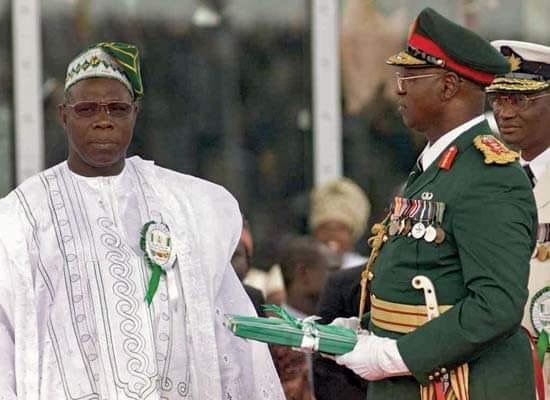
The military’s unitary system of government was not without loopholes and, thus, began a search for a new system of government by the General Murtala Muhammed-led regime which set up a Constitution Drafting Committee (CDC).
Murtala Muhammed wanted a system of government that would obliterate cut-throat political competition and discourage institutional opposition.
Obasanjo’s introduction of the American system of government has not fared any better than its predecessors, according to scholars.
A majority of the citizenry wallows in abject poverty while politicians flaunt their wealth with no fear of repercussions. Resources are unevenly distributed among the regions and this has led to agitations for restructuring, and power devolution among others.
There have also been calls for a return to the parliamentary system of government.
The Difference between the Nigerian and American Presidential systems
Despite the fact that Nigeria mirrors the U.S. system of government, the method of operation differs.
In the U.S., the federal structure has no control over the states and local government unlike in Nigeria.
Each state in the U.S. has their own constitution and is self-reliant and generates revenue from its resources to function. The states liaise more with their local governments than with the federal government. Meanwhile in Nigeria, natural resources found in states cannot be explored without the permission of the federal government.
The U.S. Constitution only specifies that states elect leaders by the people over whom they govern.
Also, the U.S. Senate only allows for two Senators per state, not minding the size of the state while House of Representatives seats are allocated based on population. However, in Nigeria, each of the 36 states has three Senators represented in the Senate and the House of Representatives has 360 members representing each of the federal constituencies of the country.
Whereas in the U.S., the President only assumes the role of being the first among equals with the state governors. In Nigeria, the President wields enormous power over the state governors. States are at the mercy of the president and have no will of their own.
In terms of remuneration, a U.S. Senator or Representative has a fixed salary but a lot of controversies have shrouded how much a Senator or a House of Rep. member earns in Nigeria. They are paid ridiculous amounts of money alongside incomprehensible allowances.
An Associate Professor in the Department of History at the Obafemi Awolowo University, Adetunji Ogunyemi, in an interview with a Nigerian newspaper, the Nigerian Tribune, argued that the presidential system of government is not favourable for Nigeria.
Ogunyemi said the U.S. model has been in existence for over 250 years, has passed the test of time, and has been able to adapt to their environment but the Nigerian situation cannot be modelled after such.

The disparity in the modus operandi of the U.S. system of government in America compared to how it works in Nigeria has led to incessant cries for restructuring. Nigeria has been plagued with socio-economic and socio-political crises and cannot afford to model a system that doesn’t suit the environment.
It should be noted that Nigeria adopted the U.S. presidential system without taking into consideration its cultural context. Some pertinent questions to answer are:
- Should the legislature be bicameral (that is, having two chambers, the Senate and the House of Representatives)?
- What is the essence of having too many cost centres at the local, state, and federal levels?
- Should the federal structure be more unitary? And a lot more.
All of these culminate in the fact that Nigeria needs to have a round table discussion on the way forward – either a complete overhaul of the constitution or a restructuring of the country.
We always have more stories to tell. So, make sure you are subscribed to our YouTube Channel and have pressed the bell button to receive notifications for interesting historical videos. Also, don’t hesitate to follow us on all our social media handles and to as well share this article with your friends.
Feel free to join our YouTube membership to enjoy awesome perks. More details here…
Sources
Adekanmbi, D. (2021, February 7). Borrowed From the US: How Nigeria Corrupted Presidentialism, Federalism. Nigerian Tribune. Retrieved from https://tribuneonlineng.com/borrowed-from-the-us-how-nigeria-corrupted-presidentialism-federalism/
Durotoye, A. (2014). One Personality, Two Regimes: A Comparative Analysis of Nigeria’s Foreign Policies under Olusegun Obasanjo. Journal of International Affairs and Global Strategy. 24 (1-12) 26-27.
Gupte, P. (1979, October 2). Civilian President Installed in Nigeria. The New York Times. Retrieved from https://www.nytimes.com/1979/10/02/archives/civilian-president-installed-in-nigeria-ending-13-years-military.html
Peterside, D. (2021, December 20). Has Democracy Failed Nigerians? Premium Times. Retrieved from https://www.premiumtimesng.com/opinion/501692-has-democracy-failed-nigerians-by-dakuku-peterside.html
Leave a Reply
You must be logged in to post a comment.

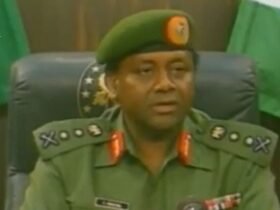
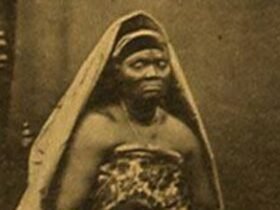
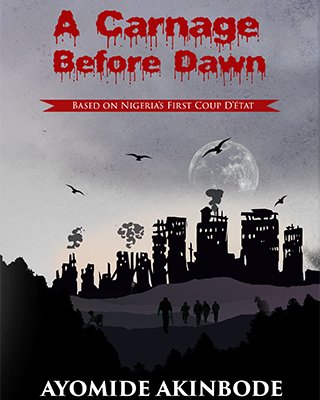



Leave a Reply
View Comments